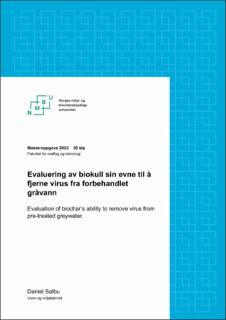| dc.contributor.advisor | Arve Heistad | |
| dc.contributor.advisor | Melesse Eshetu Moges | |
| dc.contributor.author | Salbu, Daniel | |
| dc.date.accessioned | 2023-06-24T16:27:12Z | |
| dc.date.available | 2023-06-24T16:27:12Z | |
| dc.date.issued | 2023 | |
| dc.identifier | no.nmbu:wiseflow:6753064:53015213 | |
| dc.identifier.uri | https://hdl.handle.net/11250/3073036 | |
| dc.description.abstract | Kildeseparerte avløpssystemer kan bidra til at vi istørre grad enn i dag utnytter ressursene som finnes i avløpsvannet. Ved å forske på effektive, trygge og økonomisk rimelige løsninger for lokal gjenvinning av svart- og gråvann, vil man ha muligheten til å bedre den sirkulære økonomien og potensielt også bedre livssituasjonen til mange mennesker rundt omkring i verden. Energi, næringsstoffer og vannet selv, er ressurser som kan hentes ut fra avløpet og benyttes der det trengs.
I dette forsøket ble det fokusert på utfordringen knyttet til patogene mikroorganismer ved gjenbruk av gråvann. Gråvann ble forbehandlet ved bruk av bioluftfiltrering (BAF) og deretter tilsatt viruset Salmonella typhimurium fag 28b (S.t.28b) før filtrering gjennom kolonner bestående av konvensjonelt- og mikrobølgepyrolysert biokull. Analyser av ulike parametere som turbiditet, suspendert stoff (SS), biologisk oksygenforbruk (BOD), pH og elektrisk ledningsevne (EC) ble målt fra gråvannet, fra BAF-utløpet og fra utløpene til biokullkolonnene. I tillegg ble tungmetallkonsentrasjoner i utløpene analysert. Forsøket viste at forbehandlingen av gråvann med biologisk filter kan oppnå stabil og god renseevne av BOD, SS og turbiditet. BAF-reaktoren alene har redusert turbiditeten med 96%, BOD 95%, COD med 84% of SS med 97%
Resultatene viste at biokull som skilte ut høye doser jern (5250μg L-1), hadde en evne til å redusere virus med opp mot 4LOG10. Biokull som ikke skilte ut tilsvarende konsentrasjoner jern, hadde en neglisjerbar virusreduksjon.
Forsøket skulle også undersøke veksten av biofilm på innsiden av ulike plastmaterialer for videre transport av behandlet gråvann. Dette forsøket ble ikke avsluttet på grunn av for stor usikkerhet knyttet til målingene. | |
| dc.description.abstract | Source separated sewage systems can contribute to a better use of the resources found in wastewater. By researching effective, safe and economically reasonable solutions for local recycling of black and gray water, it is possible to improve the circular economy and potentially also improve the living situation of people around the world. Energy, nutrients and the water itself are resources that can be extracted from source separated sewage systems and used where needed.
In this experiment, the focus was on the challenge associated with pathogenic microorganisms when reusing greywater Greywater was pre-treated using bio air filtration (BAF) and then added the virus Salmonella typhimurium phage 28b (S.t.28b) before filtering through columns consisting of conventional and microwave pyrolysed biochar. Analyzes of various parameters such as turbidity, suspended solids (SS), biological oxygen consumption (BOD), pH and electrical conductivity (EC) were measured from the greywater, from the BAF outlet and from the outlets of the biochar columns. In addition, heavy metal concentrations in the outlets were analysed. The experiment showed that the pre-treatment of gray water with a biological filter can achieve stable and good cleaning performance of BOD, SS and turbidity. The BAF reactor alone reduced turbidity by 96%, BOD by 95%, COD by 84% and SS by 97%.
The results showed that MAP-biochar that with high doses of iron (5250μg L-1) had an ability to reduce viruses by up to 4LOG10. Biochar that did not have similar concentrations of iron had a negligible virus reduction. The experiment also wanted to investigate the growth of biofilm on the inside of various plastic materials for further transport of treated greywater. This experiment was not completed due to too great uncertainties associated with the measurements. | |
| dc.language | nob | |
| dc.publisher | Norwegian University of Life Sciences | |
| dc.title | Evaluering av biokull sin evne til å fjerne virus fra forbehandlet gråvann | |
| dc.type | Master thesis | |
